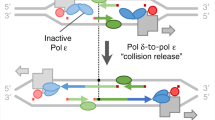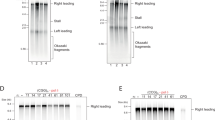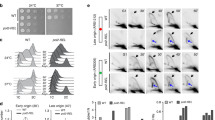Abstract
Maintaining the chemical identity of DNA depends on ribonucleotide exclusion by DNA polymerases. However, ribonucleotide exclusion during DNA synthesis in vitro is imperfect. To determine whether ribonucleotides are incorporated during DNA replication in vivo, we substituted leucine or glycine for an active-site methionine in yeast DNA polymerase ϵ (Pol ϵ). Ribonucleotide incorporation in vitro was three-fold lower for M644L and 11-fold higher for M644G Pol ϵ compared to wild-type Pol ϵ. This hierarchy was recapitulated in vivo in yeast strains lacking RNase H2. Moreover, the pol2-M644G rnh201Δ strain progressed more slowly through S phase, had elevated dNTP pools and generated 2–5-base-pair deletions in repetitive sequences at a high rate and in a gene orientation–dependent manner. The data indicate that ribonucleotides are incorporated during replication in vivo, that they are removed by RNase H2–dependent repair and that defective repair results in replicative stress and genome instability via DNA strand misalignment.
This is a preview of subscription content, access via your institution
Access options
Subscribe to this journal
Receive 12 print issues and online access
$259.00 per year
only $21.58 per issue
Buy this article
- Purchase on Springer Link
- Instant access to full article PDF
Prices may be subject to local taxes which are calculated during checkout




Similar content being viewed by others
References
Joyce, C.M. Choosing the right sugar: how polymerases select a nucleotide substrate. Proc. Natl. Acad. Sci. USA 94, 1619–1622 (1997).
Nick McElhinny, S.A. et al. Abundant ribonucleotide incorporation into DNA by yeast replicative polymerases. Proc. Natl. Acad. Sci. USA 107, 4949–4954 (2010).
Kornberg, A. & Baker, T.A. DNA Replication 2nd ed. (W.H. Freeman, New York, 1992).
Traut, T.W. Physiological concentrations of purines and pyrimidines. Mol. Cell. Biochem. 140, 1–22 (1994).
Pursell, Z.F., Isoz, I., Lundstrom, E.B., Johansson, E. & Kunkel, T.A. Yeast DNA polymerase epsilon participates in leading-strand DNA replication. Science 317, 127–130 (2007).
Nick McElhinny, S.A., Gordenin, D.A., Stith, C.M., Burgers, P.M. & Kunkel, T.A. Division of labor at the eukaryotic replication fork. Mol. Cell 30, 137–144 (2008).
Rossi, M.L., Purohit, V., Brandt, P.D. & Bambara, R.A. Lagging strand replication proteins in genome stability and DNA repair. Chem. Rev. 106, 453–473 (2006).
Burgers, P.M. Polymerase dynamics at the eukaryotic DNA replication fork. J. Biol. Chem. 284, 4041–4045 (2009).
DeLucia, A.M., Grindley, N.D. & Joyce, C.M. An error-prone family Y DNA polymerase (DinB homolog from Sulfolobus solfataricus) uses a 'steric gate' residue for discrimination against ribonucleotides. Nucleic Acids Res. 31, 4129–4137 (2003).
Bonnin, A., Lazaro, J.M., Blanco, L. & Salas, M. A single tyrosine prevents insertion of ribonucleotides in the eukaryotic-type phi29 DNA polymerase. J. Mol. Biol. 290, 241–251 (1999).
Gardner, A.F. & Jack, W.E. Determinants of nucleotide sugar recognition in an archaeon DNA polymerase. Nucleic Acids Res. 27, 2545–2553 (1999).
Yang, G., Franklin, M., Li, J., Lin, T.C. & Konigsberg, W. A conserved Tyr residue is required for sugar selectivity in a Pol alpha DNA polymerase. Biochemistry 41, 10256–10261 (2002).
Pavlov, Y.I., Shcherbakova, P.V. & Kunkel, T.A. In vivo consequences of putative active site mutations in yeast DNA polymerases alpha, epsilon, delta, and zeta. Genetics 159, 47–64 (2001).
Astatke, M., Ng, K., Grindley, N.D. & Joyce, C.M. A single side chain prevents Escherichia coli DNA polymerase I (Klenow fragment) from incorporating ribonucleotides. Proc. Natl. Acad. Sci. USA 95, 3402–3407 (1998).
Shinkai, A., Patel, P.H. & Loeb, L.A. The conserved active site motif A of Escherichia coli DNA polymerase I is highly mutable. J. Biol. Chem. 276, 18836–18842 (2001).
Rydberg, B. & Game, J. Excision of misincorporated ribonucleotides in DNA by RNase H (type 2) and FEN-1 in cell-free extracts. Proc. Natl. Acad. Sci. USA 99, 16654–16659 (2002).
Eder, P.S. & Walder, J.A. Ribonuclease H from K562 human erythroleukemia cells. Purification, characterization, and substrate specificity. J. Biol. Chem. 266, 6472–6479 (1991).
Eder, P.S., Walder, R.Y. & Walder, J.A. Substrate specificity of human RNase H1 and its role in excision repair of ribose residues misincorporated in DNA. Biochimie 75, 123–126 (1993).
Cerritelli, S.M. & Crouch, R.J. Ribonuclease H: the enzymes in eukaryotes. FEBS J. 276, 1494–1505 (2009).
Pursell, Z.F., Isoz, I., Lundstrom, E.B., Johansson, E. & Kunkel, T.A. Regulation of B family DNA polymerase fidelity by a conserved active site residue: characterization of M644W, M644L and M644F mutants of yeast DNA polymerase epsilon. Nucleic Acids Res. 35, 3076–3086 (2007).
Chabes, A. et al. Survival of DNA damage in yeast directly depends on increased dNTP levels allowed by relaxed feedback inhibition of ribonucleotide reductase. Cell 112, 391–401 (2003).
Qiu, J., Qian, Y., Frank, P., Wintersberger, U. & Shen, B. Saccharomyces cerevisiae RNase H(35) functions in RNA primer removal during lagging-strand DNA synthesis, most efficiently in cooperation with Rad27 nuclease. Mol. Cell. Biol. 19, 8361–8371 (1999).
Chen, J.Z., Qiu, J., Shen, B. & Holmquist, G.P. Mutational spectrum analysis of RNase H(35) deficient Saccharomyces cerevisiae using fluorescence-based directed termination PCR. Nucleic Acids Res. 28, 3649–3656 (2000).
Jeong, H.S., Backlund, P.S., Chen, H.C., Karavanov, A.A. & Crouch, R.J. RNase H2 of Saccharomyces cerevisiae is a complex of three proteins. Nucleic Acids Res. 32, 407–414 (2004).
Frank, P., Braunshofer-Reiter, C., Karwan, A., Grimm, R. & Wintersberger, U. Purification of Saccharomyces cerevisiae RNase H(70) and identification of the corresponding gene. FEBS Lett. 450, 251–256 (1999).
Bebenek, K. & Kunkel, T.A. Frameshift errors initiated by nucleotide misincorporation. Proc. Natl. Acad. Sci. USA 87, 4946–4950 (1990).
Kunkel, T.A., Hamatake, R.K., Motto-Fox, J., Fitzgerald, M.P. & Sugino, A. Fidelity of DNA polymerase I and the DNA polymerase I-DNA primase complex from Saccharomyces cerevisiae. Mol. Cell. Biol. 9, 4447–4458 (1989).
Cai, H., Yu, H., McEntee, K., Kunkel, T.A. & Goodman, M.F. Purification and properties of wild-type and exonuclease-deficient DNA polymerase II from Escherichia coli. J. Biol. Chem. 270, 15327–15335 (1995).
Crow, Y.J. et al. Mutations in genes encoding ribonuclease H2 subunits cause Aicardi-Goutieres syndrome and mimic congenital viral brain infection. Nat. Genet. 38, 910–916 (2006).
Hamatake, R.K. et al. Purification and characterization of DNA polymerase II from the yeast Saccharomyces cerevisiae. Identification of the catalytic core and a possible holoenzyme form of the enzyme. J. Biol. Chem. 265, 4072–4083 (1990).
Chilkova, O., Jonsson, B.H. & Johansson, E. The quaternary structure of DNA polymerase epsilon from Saccharomyces cerevisiae. J. Biol. Chem. 278, 14082–14086 (2003).
Kokoska, R.J., McCulloch, S.D. & Kunkel, T.A. The efficiency and specificity of apurinic/apyrimidinic site bypass by human DNA polymerase η and Sulfolobus solfataricus Dpo4. J. Biol. Chem. 278, 50537–50545 (2003).
Pavlov, Y.I. et al. Correlation of somatic hypermutation specificity and A-T base pair substitution errors by DNA polymerase eta during copying of a mouse immunoglobulin kappa light chain transgene. Proc. Natl. Acad. Sci. USA 99, 9954–9959 (2002).
Kirchner, J.M., Tran, H. & Resnick, M.A.A. DNA polymerase epsilon mutant that specifically causes +1 frameshift mutations within homonucleotide runs in yeast. Genetics 155, 1623–1632 (2000).
Sambrook, J., Fritsch, E.F. & Maniatis, T. Molecular Cloning: A Laboratory Journal, 2nd Edition (Cold Spring Harbor Press, Cold Spring Harbor, New York), 6.20–6.21 (1989).
Sabouri, N., Viberg, J., Goyal, D.K., Johansson, E. & Chabes, A. Evidence for lesion bypass by yeast replicative DNA polymerases during DNA damage. Nucleic Acids Res. 36, 5660–5667 (2008).
Shcherbakova, P.V. & Kunkel, T.A. Mutator phenotypes conferred by MLH1 overexpression and by heterozygosity for mlh1 mutations. Mol. Cell. Biol. 19, 3177–3183 (1999).
Acknowledgements
We thank K. Bebenek and J. Williams for thoughtful comments on the manuscript and the National Institute of Environmental Health Sciences Molecular Genetics Core for technical support in DNA sequence analysis of ura3 mutants. This work was supported in part by Project Z01 ES065070 (to T.A.K.) from the Division of Intramural Research of the US National Institutes of Health, National Institute of Environmental Health Sciences, in part by the Swedish Foundation for Strategic Research, the Swedish Research Council and the Swedish Cancer Society (to A.C.) and in part by the Swedish Research Council, the Swedish Cancer Society, Smärtafonden and the fund for Basic Science–oriented Biotechnology, Medical Faculty of Umeå University (to E.J.).
Author information
Authors and Affiliations
Contributions
S.A.N.M., D.K., A.B.C., B.E.W. and D.L.W. performed the experiments and analyzed the data; E.-B.L. contributed reagents; E.J., A.C. and T.A.K. designed the experiments and analyzed data; T.A.K. wrote the manuscript; and all authors edited the manuscript.
Corresponding author
Ethics declarations
Competing interests
The authors declare no competing financial interests.
Rights and permissions
About this article
Cite this article
McElhinny, S., Kumar, D., Clark, A. et al. Genome instability due to ribonucleotide incorporation into DNA. Nat Chem Biol 6, 774–781 (2010). https://doi.org/10.1038/nchembio.424
Received:
Accepted:
Published:
Issue Date:
DOI: https://doi.org/10.1038/nchembio.424
This article is cited by
-
Bacterial DNA excision repair pathways
Nature Reviews Microbiology (2022)
-
RNaseH2A downregulation drives inflammatory gene expression via genomic DNA fragmentation in senescent and cancer cells
Communications Biology (2022)
-
DTYMK is essential for genome integrity and neuronal survival
Acta Neuropathologica (2022)
-
Signatures of TOP1 transcription-associated mutagenesis in cancer and germline
Nature (2022)
-
Structural basis for proficient oxidized ribonucleotide insertion in double strand break repair
Nature Communications (2021)



